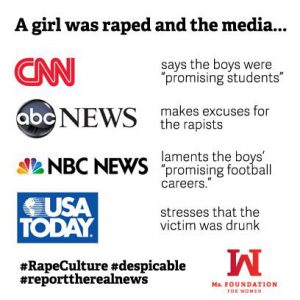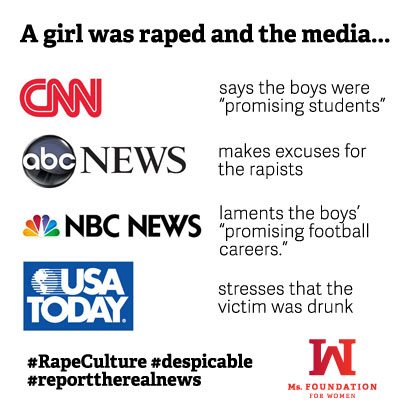by Annemarie McDaniel
As the nation watched the Steubenville rape case come to a close, we also watched something else happen: the coverage of multiple news sources sympathized with the convicted rapists while ignoring the narrative of Jane Doe. The good old Internet has exploded, calling out how media’s coverage was offensive to the victim and apologetic of the rapists. A Ms. Foundation for Women graphic with over 100,000 shares on Facebook and a petition with more than 280,000 signatures asking for CNN to apologize on air for their coverage are just the tip of the online criticism iceberg. It’s clear that rape culture is being publicly discussed more and more, creating progress by keeping the media accountable. However, we can’t just shout about how the media is wrong: we also have to point out specifically what is inappropriate and why, or else media will keep making the same mistakes.
news sources sympathized with the convicted rapists while ignoring the narrative of Jane Doe. The good old Internet has exploded, calling out how media’s coverage was offensive to the victim and apologetic of the rapists. A Ms. Foundation for Women graphic with over 100,000 shares on Facebook and a petition with more than 280,000 signatures asking for CNN to apologize on air for their coverage are just the tip of the online criticism iceberg. It’s clear that rape culture is being publicly discussed more and more, creating progress by keeping the media accountable. However, we can’t just shout about how the media is wrong: we also have to point out specifically what is inappropriate and why, or else media will keep making the same mistakes.
Here are three different ways the new outlets perpetuated rape culture.
1) CNN’s coverage by anchor Candy Crowley and reporter Poppy Harlow mourned the “young men that had such promising futures, star football players, very good students” whose “lives fell apart” because of the case, portraying the two football players as the ones who suffered most from the rape. CNN ignored the experience and story of the victim entirely. When girls see Jane Doe ignored while her rapists receive sympathy, it makes reporting rape that much more difficult because it feels like we won’t be taken seriously, or that people won’t care. Rape is already underreported, and national media showing emotion about rapists rather than victims makes things much worse.
2) ABC 20/20 reporters began an online article stated the case was “every parent’s nightmare,” but they weren’t talking about it being a nightmare for the victim’s parents. ABC wasn’t referring to the horror of finding out that your daughter was drugged, peed on, and raped in front of her own peers. No, ABC claimed that the events in Steubenville were “a cautionary tale for teenagers living in today’s digital world,” as though the problem is that the rapists got caught rather than the fact that a rape happened at all. Instead of focusing on the root of the issue—sexual assault, rape culture, misogyny, the rape itself–ABC only addressed how tweets, images, and videos can multiply the damaging effects of the rape on the community and resurface even after being deleted. Steubenville isn’t a cautionary tale about social media, it’s a cautionary tale about how society needs to change the way we educate boys about rape and consent.
3) USA Today, instead of discussing the actual rape, wrote an entire article insinuating that Jane Doe was drunk, unreliable, and asking to be assaulted. The article opens by noting that the accused were “raping a drunken 16-year-old girl at an all-night party,” and continuously mentions what types of drinks she had, her fuzzy memory of the evening, and her friend’s account that may have Jane Doe changed her story. USA Today portrayed Jane Doe as too drunk to make decisions, and instead of talking about how abhorrent it is that her rapists took advantage of her in that state, the article suggests that she’s at fault for making poor decisions. The article ends with how “the accuser had been flirting with Richmond at the party” and how her friends stated how “she has a history of drinking and has lied about things in the past.” USA Today is trying to portray her as “slutty” and thus immoral, as if flirtatiously touching a guy’s chest at a party is giving him invitation to pee on you. They only mention the actual rape for one sentence. Although a full description of the rape could be disturbing and graphic, simply saying she was “sexually assaulted” sounds uncertain and tame compared to saying that multiple witnesses saw the two football players penetrate her with their fingers in a car and a basement, try to force her into oral sex, rub her groin area while she was unconscious, and smack their junk off her side while she was extremely intoxicated and not participating. Word choice matters.
Trent Mays and Ma’lik Richmond, like the rest of us, grew up in a culture where rape jokes are common, sexual consent is rarely discussed, and masculinity is based on “scoring” with women. This fact doesn’t make their actions acceptable, but it does mean they are more common than we like to tell ourselves. Although Steubenville gained national media attention, it was far from an isolated incident. 15% of sexual assault and rape victims are under age 12, and 44% are under age 18, and for juvenile sexual assault victims, 58.7% said their attacker was an acquaintance. The statistics show that young girls (and some boys too) are just as likely to be sexually assault victims as adults are, and that the majority of assaults is from their own friends or peers.
That’s why the work of SPARK and our partners is so crucial. We cannot just let Steubenville fade into the background and wait for the next high profile sexual assault to happen before we talk about these issues again. When we educate coaches, the role models and mentors for young athletes, we create a space for boys to learn about consent and ending sexual violence. Sign our petition at change.org/educatecoaches so we can be one step closer to ending future Steubenvilles.
Here are some partner organizations that we love who are doing work on sexual violence prevention, compiled by SPARK activist Carmen Rios. If you know other orgs doing good work, leave them in the comments!
THE LINE Campaign
An interactive and dynamic campus- and community-based effort to start discussions around consent, sex, power, and pleasure that bring everyone to the table and happen in real life, on social media, and in the classroom.
THE LINE, produced and directed by Nancy Schwartzman, is the central point of the dialogue – a short documentary following her experience after a rape that also brings in lawyers, activist Don McPherson, and sex workers from The Bunny Ranch in Las Vegas. The film and the campaign’s other videos have been viewed over 83,000 times and have screened over 1,000 times around the globe. None of the discussions are about what women do to “invite” or “defend from” violence. The discussions are about how we transform a culture into a sex-positive, consent-enthusiastic one. And that means involving everyone in the work.
MEN CAN STOP RAPE
A national organization educating and engaging men on strategies for active nonviolence. Men Can Stop Rape’s campaign packages, on-campus organizations for university men, and educational programs bring men’s voices to the movement to end rape in an effort to create a less toxic mold of masculinity for boys and men in this country, and their work has reached over 2 million people.
MASCULINITY U
A coalition working to change how boys and men think about and define masculinity. They have a national speakers bureau, curriculum development, advocacy and programmatic consulting, and guided facilitation.
MEN STOPPING VIOLENCE
An organization educated to educating men nationally about domestic violence and abuse in order to foster healthier and happier partnerships and homes. They’ve worked with over 60,000 men and trained over 1,000,000 people, leading to an 85 percent increase in willingness to intervene in unhealthy and abusive situations.
GREEN DOT
Green Dot started at the University of Kentucky and now works to train administrators and activists on college campuses on bystander intervention across the United States. By empowering sustainable university community members – staff and administrators – to train and inform students about successful strategies for preventing power-based personal violence, they actively engage communities in ending bystander apathy and creating a new culture where violence is less sustainable. The program now exists across the world.

[…] http://www.sparksummit.com/2013/03/26/steubenville-media-coverage-got-it-wrong-so-how-do-we-get-it-r… […]
Just because a girl is drunk or wearing little clothing, DOESN’T MEAN SHE ASKED TO BE RAPED.